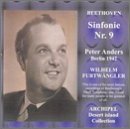| All Artists: Ludwig van Beethoven, Wilhelm Furtwängler, Berlin Philharmonic Orchestra, Tilla Briem, Peter Anders Title: Beethoven: Symphonie Nr. 9 Members Wishing: 0 Total Copies: 0 Label: Archipel Release Date: 6/28/2000 Album Type: Import Genre: Classical Styles: Historical Periods, Classical (c.1770-1830), Modern, 20th, & 21st Century, Symphonies Number of Discs: 1 SwapaCD Credits: 1 UPCs: 675754213220, 7640104000020 |
Search - Ludwig van Beethoven, Wilhelm Furtwängler, Berlin Philharmonic Orchestra :: Beethoven: Symphonie Nr. 9
 | Ludwig van Beethoven, Wilhelm Furtwängler, Berlin Philharmonic Orchestra Beethoven: Symphonie Nr. 9 Genre: Classical
|
Larger Image |
CD Details |
CD ReviewsHistoric Recording David Mente | Pittsburgh, PA | 04/16/2002 (5 out of 5 stars) "This is a performance which is quite famous because it was a live performance in Berlin during WW2 conducted by Furtwangler, acknowledged by many then and now as the greatest conductor of his time. Furtwangler's performance performance may be the most intense performance of this piece ever recorded. It is hard not to attribute this to the circumstances of those times. This is, however, not for everyone. If you are looking for a starter ninth, look elsewhere, or if you want great sound. This is from 1942. The sound is poor by todays standards. If you are interested in exploring great performances of the past, this is a Ninth that is unique and well worth exploring." His greatest symphony magellan | Santa Clara, CA | 10/04/2000 (5 out of 5 stars) "No doubt the master's greatest symphony, conducted by one of the 20th centuries greatest conductors.A lot has already been written about this great symphony, so I will just add one interesting fact I learned about it that most people probably aren't aware of.There is an odd story behind the famous "Ode to Joy" theme in the first movement. When Beethoven was writing this symphony, Vienna was in the grip of a real musical craze, for--I kid you not--Turkish military band music. I don't know much about Turkish military band music myself, but it must have been pretty catchy stuff for early 19th century Austrians, because they were going nuts over it. This famous theme is the master's recognition of, and contribution to, this craze, and the Viennese loved it. Hence the use of the piccolo during this section, a popular band instrument.This might also be example of the master's ironic musical sense of humor. Another example of this is the theme in the Lenore Overture which is played by the entire string section, where he basically makes them practice their scales in public. Beethoven also composed a piece called "Ich bin der schnieder cockadoo," which translates as "I am the taylor's cockatoo," so don't ever let anybody tell you that Beethoven didn't have a sense of humor." : Who will conduct a Beethoven Symphony after him?. Hiram Gomez Pardo | Valencia, Venezuela | 08/05/2005 (5 out of 5 stars) "1942: It's wartime. Once more Wilhelm Fürtwangler conducts this work. But this is not another additional performance.
Fürtwangler has decided that evening that the Ninth must elevate far beyond the podium and the hall. Something in the enviroment will be shocked since the first bars. In the First Movement the cosmic fury and the tragic mood face one each other. The Adagio is a true Requiem; the baton of W.F. works out as Achilles sword. This Symphony that evening will mean a clear message for the present listeners and thinking about the listeners of the future: the end is near. Never before in the story of the music a performance will resound like this one. The intrepretative violence is not gratuite: Every time Fürtwnagler conducted Beethoven it was a true ritual a real cathartic experience. This historical recording overpasses by far, all the adjectives to become a cosmic experience. Who will conduct a Beethoven Symphony after him?." |

 Track Listings (4) - Disc #1
Track Listings (4) - Disc #1